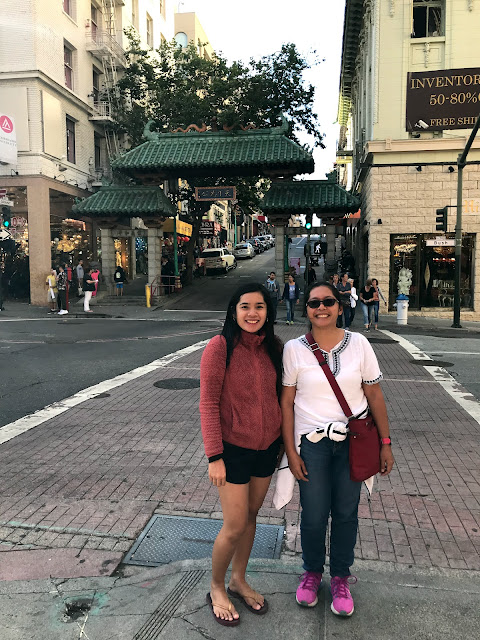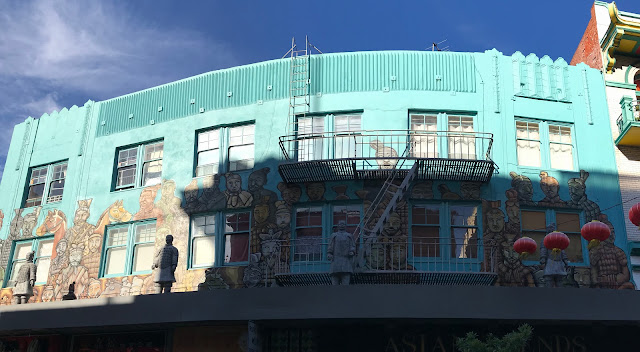Walking from China to Italy and back to San Francisco in one afternoon
San Francisco is such a cosmopolitan city. It's like putting miniatures of different countries in close proximity with each other. For instance, after our visit to the Museum of African Diaspora, we proceeded to walk to the Dragon Gate, Chinatown's southern entrance. The sun was still high up in the summer sky and we found the gate crowded by tourists taking souvenir photos. In fact, our photo was taken by a guy who thought that we were tourists too. Well, we were tourists for the day...
Two Chinese guardian lions were seated in front of the gate. I'm always happy to these stone statues because they look happy... particularly this lioness, who appeared to be playing with a lion cub.
As if we hadn't seen enough lions yet, Anna located a third sculpture just outside a shop. This one's more like the adult Simba; it's on display along with statues of pandas and of the infamous wise monkeys.
The length of Grant Street felt like a movie set standing in for a Chinese marketplace, with all the shops with Chinese names, the tourists wearing farmer hats, and the peking ducks hanging from shopfronts. In some alleys, we found murals depicting dragons, Bruce Lee, Buddha, traditional theatre characters, and terracotta warriors.
The festive atmosphere (and the stereotype) was further enhanced by the red lanterns hanging above street level. To many tourists, this is the sign that they truly were in Chinatown.
As Anna and I continued walking, we noticed that the Chinese theme was slowly diminishing as we got farther from the centre of Chinatown. The terracotta warriors standing guard on the second floor of a building appeared to bid us a safe journey.
And just like that, we were in Little Italy, an area where people with Italian ancestry settled a long time ago. I couldn't tell though, because it was filled by tourists. What confirmed that we were in Little Italy were the cafés, shops, and restaurants that featured Italian cuisine... oh, and the little tables outside, so that diners could watch the hustle and bustle of this community as they ate.
Anna and I decided to have dinner at a restaurant called Calzone's Restaurant. It's found in the heart of Little Italy. Apparently, we ordered two of the restaurant's signature dishes: an oblong (mushroom) pizza and the plate of Italian potstickers.
The oblong pizza definitely reminded me of Cibo, one of the restaurants that started me off on my gastronomy adventure. Anyway, I'm not sure if Calzone's oblong pizza is the same as pizza alla pala but it's certainly delicious. I particularly loved the earthy flavours that the mushroom contributed to the pizza and how they blended with the flavours and textures of the cheese. And the crust? Perfectly made, in my opinion. The Italian potstickers, on the other hand, reminded me of siomai because the potstickers were essentially dumplings sitting on a bed of arugula dressed with a mixture of soy sauce and sesame oil. Both dishes gave us an insight about why people kept going to Calzone's. Definitely a good choice.
We resumed our walk, this time, towards the CBD. That's when I realised that we were approaching the Transamerica Pyramid. During my previous visits to the City, I have never gotten this close to this particular building; it's the second tallest skyscraper in San Francisco right now. Naturally, I was excited.
It was fun going around in the City on foot; definitely better than just driving around the place. There's something immersive about walking here... we were definitely not just passing through.










Comments
Post a Comment
Thank you for dropping by!
Before moving on, please share your thoughts or comments about the post. :)
Thanks again!